Name Jim Brown | Height 1.88 m Weight 105 kg | |
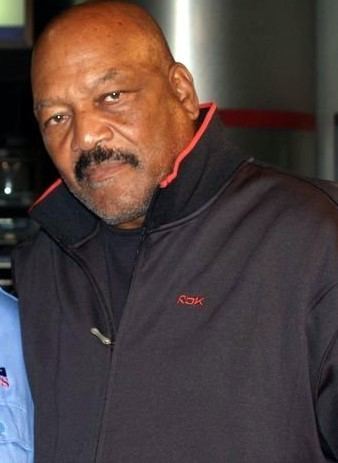 | ||
Date of birth: (1936-02-17) February 17, 1936 (age 79) NFL draft: 1957 / Round: 1 / Pick: 6 Spouse Monique Brown (m. 1997), Sue Brown (m. 1959–1972) Movies The Dirty Dozen, 100 Rifles, Slaughter, The Running Man, Any Given Sunday Similar People Profiles | ||
Place of birth: St. Simons, Georgia | ||
Jim brown career highlight
James Nathaniel Brown (born February 17, 1936) is a former professional American football player and actor. He was a fullback for the Cleveland Browns of the National Football League (NFL) from 1957 through 1965. Considered to be among the greatest football players of all time, Brown was a Pro Bowl invitee every season he was in the league, was recognized as the AP NFL Most Valuable Player three times, and won an NFL championship with the Browns in 1964. He led the league in rushing yards in eight out of his nine seasons, and by the time he retired, he had shattered most major rushing records. In 2002, he was named by The Sporting News as the greatest professional football player ever.
Contents
- Jim brown career highlight
- Jim Brown Ultimate Highlights Part 1
- Early life
- College sports career
- Professional football career
- Acting career
- Other after football activities
- Legal troubles and controversy
- Football accolades
- NFL career statistics
- References
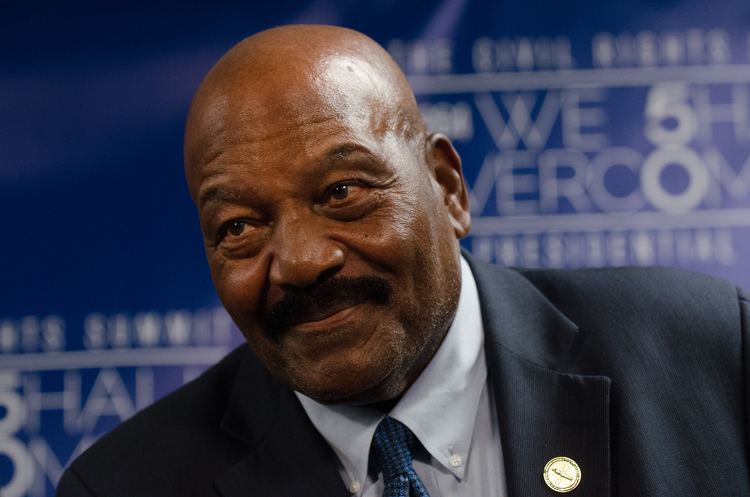
Brown earned unanimous All-America honors playing college football at Syracuse University in New York, where he was an all-around player for the Syracuse Orangemen football team. He also excelled in basketball, track and field, and lacrosse. The football team later retired his number 44 jersey. He was inducted into the College Football Hall of Fame in 1995.
In his professional career, Brown carried the ball 2,359 times for 12,312 rushing yards and 106 touchdowns, which were all records when he retired. He averaged 104.1 rushing yards per game, and is the only player in NFL history to average over 100 rushing yards per game for his career. His 5.2 yards per rush is third-best among running backs. Brown was enshrined in the Pro Football Hall of Fame in 1971. He was named to the NFL 75th Anniversary All-Time Team, comprising the best players in NFL history. His number 32 jersey is retired by the Browns. Shortly after his football career, Brown became an actor, and had several leading roles throughout the 1970s.
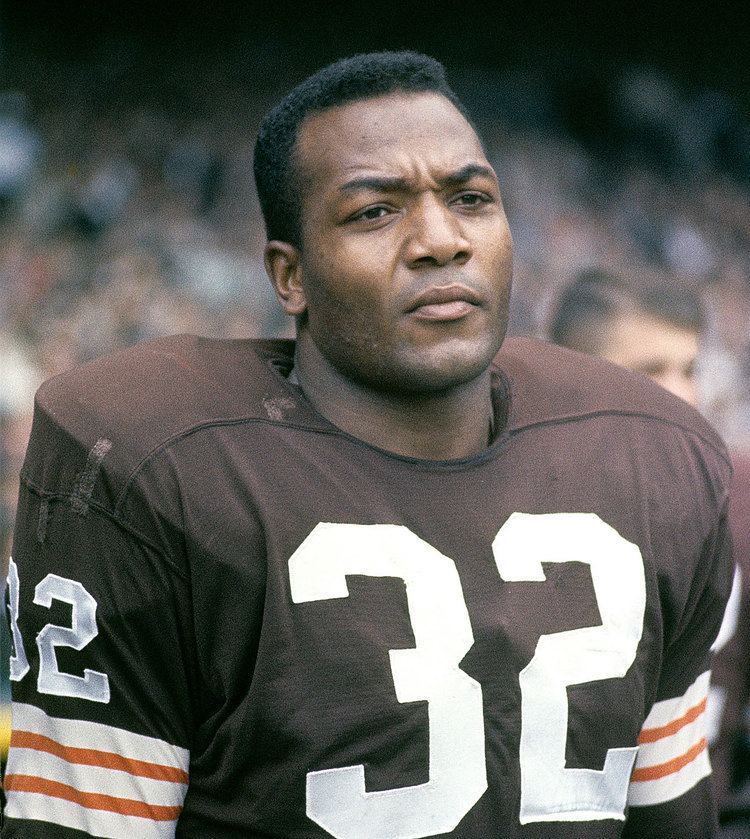
Jim Brown Ultimate Highlights Part 1
Early life
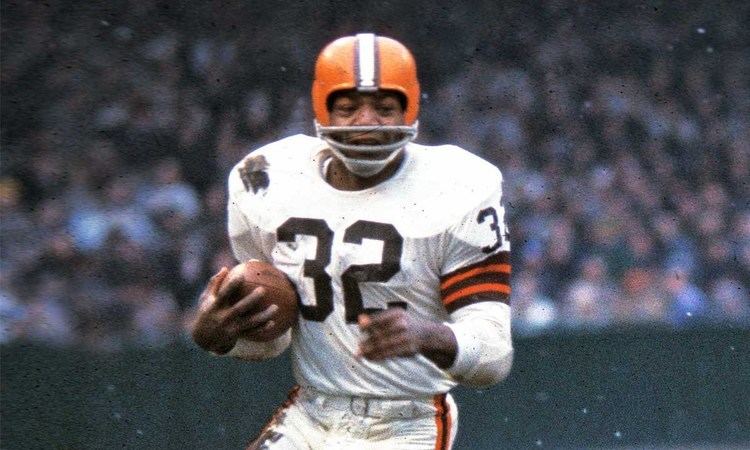
Brown was born in St. Simons Island, Georgia, to Swinton Brown, a professional boxer, and his wife, Theresa, a homemaker.
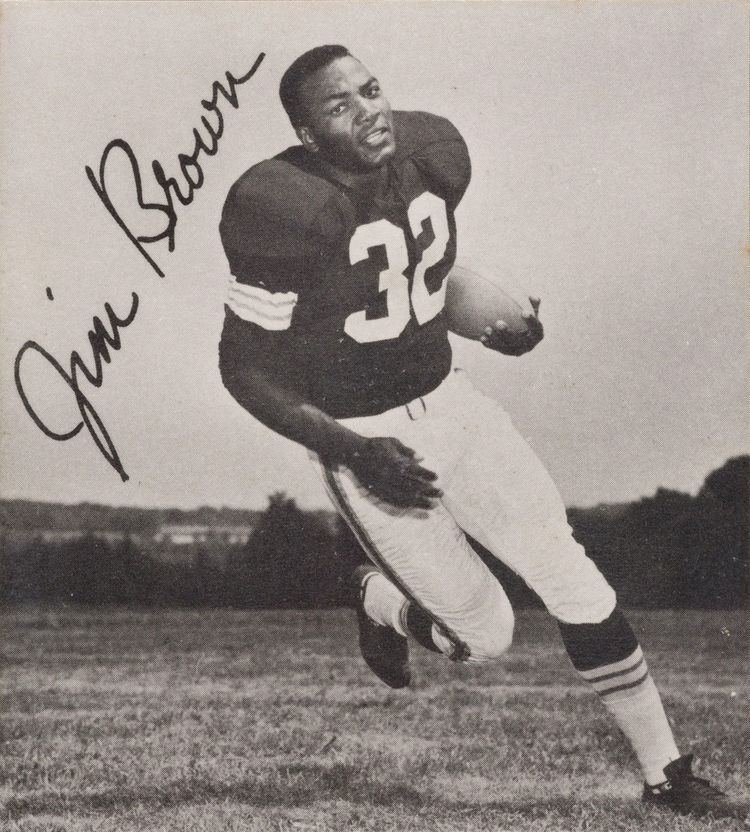
At Manhasset Secondary School, Brown earned 13 letters playing football, lacrosse, baseball, and basketball, and running track.
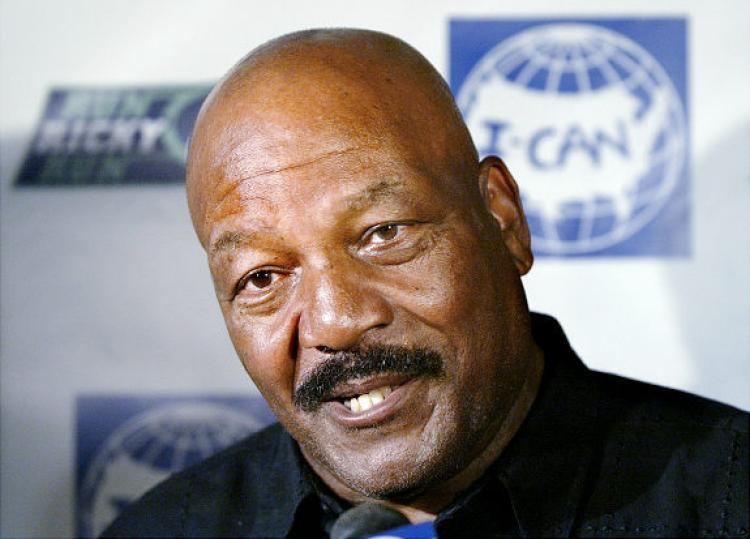
Mr. Brown credits his self-reliance to having grown up on Saint Simons Island, a community off the coast of Georgia where he was raised by his grandmother and where racism did not affect him directly. At the age of eight, he moved to Manhasset, New York, on Long Island, where his mother worked as a domestic. It was at Manhasset High School that he became a football star and athletic legend.
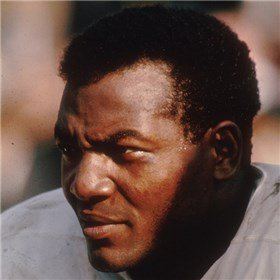
He averaged a then-Long Island record 38 points per game for his basketball team. That record was later broken by future Boston Red Sox star Carl Yastrzemski of Bridgehampton.
College sports career
As a sophomore at Syracuse University (1954), Brown was the second-leading rusher on the team. As a junior, he rushed for 666 yards (5.2 per carry). In his senior year in 1956, Brown was a consensus first-team All-American. He finished fifth in the Heisman Trophy voting and set school records for highest season rush average (6.2) and most rushing touchdowns in a single game (6). He ran for 986 yards—third-most in the country despite Syracuse playing only eight games—and scored 14 touchdowns. In the regular-season finale, a 61–7 rout of Colgate, he rushed for 197 yards, scored six touchdowns, and kicked seven extra points for a school-record 43 points. Then in the Cotton Bowl, he rushed for 132 yards, scored three touchdowns, and kicked three extra points, but a blocked extra point after Syracuse's third touchdown was the difference as TCU won 28–27.
Brown is a member of The Pigskin Club of Washington, D.C. National Intercollegiate All-American Football Players Honor Roll.
Perhaps more impressive was his success as a multisport athlete. In addition to his football accomplishments, he excelled in basketball, track, and especially lacrosse. As a sophomore, he was the second-leading scorer for the basketball team (15 ppg), and earned a letter on the track team. In 1955, he finished in fifth place in the Nation Championship decathlon. His junior year, he averaged 11.3 points in basketball, and was named a second-team All-American in lacrosse. His senior year, he was named a first-team All-American in lacrosse (43 goals in 10 games to rank second in scoring nationally). The Carrier Dome has an 800 square-foot tapestry depicting Brown in football and lacrosse uniforms with the words "Greatest Player Ever".
Professional football career
Brown was taken in the first round of the 1957 NFL draft by the Cleveland Browns, the sixth overall selection. In the ninth game of his rookie season, against the Los Angeles Rams he rushed for 237 yards, setting an NFL single-game record that stood unsurpassed for 14 years and a rookie record that remained for 40 years. After only nine years in the NFL, he departed as the league's record holder for both single-season (1,863 in 1963) and career rushing (12,312 yards), as well as the all-time leader in rushing touchdowns (106), total touchdowns (126), and all-purpose yards (15,549). He was the first player ever to reach the 100-rushing-touchdowns milestone, and only a few others have done so since, despite the league's expansion to a 16-game season in 1978 (Brown's first four seasons were only 12 games, and his last five were 14 games).
Brown's record of scoring 100 touchdowns in only 93 games stood until LaDainian Tomlinson did it in 89 games during the 2006 season. Brown holds the record for total seasons leading the NFL in all-purpose yards (five: 1958–1961, 1964), and is the only rusher in NFL history to average over 100 yards per game for a career. In addition to his rushing, Brown was a superb receiver out of the backfield, catching 262 passes for 2,499 yards and 20 touchdowns, while also adding another 628 yards returning kickoffs.
Every season he played, Brown was voted into the Pro Bowl, and he left the league in style by scoring three touchdowns in his final Pro Bowl game. He accomplished these records despite not playing past 29 years of age. Brown's six games with at least four touchdowns remains an NFL record. Tomlinson and Marshall Faulk both have five games with four touchdowns.
Brown led the league in rushing a record eight times. He was also the first NFL player ever to rush for over 10,000 yards.
He told me, 'Make sure when anyone tackles you he remembers how much it hurts.' He lived by that philosophy and I always followed that advice.
Brown's 1,863 rushing yards in the 1963 season remain a Cleveland franchise record. It is currently the oldest franchise record for rushing yards out of all 32 NFL teams. His average of 133 yards per game that season is exceeded only by O. J. Simpson's 1973 season. While others have compiled more prodigious statistics, when viewing Brown's standing in the game, his style of running must be considered along with statistical measures. He was very difficult to tackle (shown by his leading 5.2 yards per carry), often requiring more than one defender to bring him down.
Brown retired in July 1966, after only nine seasons, as the NFL's all-time leading rusher. He held the record of 12,312 yards until it was broken by Walter Payton on October 7, 1984, during Payton's 10th NFL season. Brown is still the Cleveland Browns all-time leading rusher. Currently Jim Brown is ninth on the all-time rushing list.
During Brown's career, Cleveland won the NFL championship in 1964 and were runners-up in 1957 and 1965, his rookie and final season, respectively.
Acting career
Brown began an acting career before the 1964 season, playing a buffalo soldier in a Western action film called Rio Conchos. The film premiered at Cleveland's Hippodrome theater on October 23, with Brown and many of his teammates in attendance. The reaction was lukewarm. Brown, one reviewer said, was a serviceable actor, but the movie's overcooked plotting and implausibility amounted to "a vigorous melodrama for the unsqueamish."
In early 1966, Brown was shooting his second film in London. The Dirty Dozen cast Brown as Robert Jefferson, one of 12 convicts sent to France during World War II to assassinate German officers meeting at a castle near Rennes in Brittany before the D-Day invasion. Production delays due to bad weather meant he missed at least the first part of training camp on the campus of Hiram College, which annoyed Cleveland Browns owner Art Modell, who threatened to fine Brown $1,500 for every week of camp he missed. Brown, who had previously said that 1966 would be his last season, the final year of a three-year contract, announced his retirement, instead. At the end of his nine-year career, Brown held records for most rushing yards in a game, a season, and a career. He also owned the record for all-purpose yards in a career and best average per carry for a running back at 5.22 yards, a mark that still stands.
Brown went on to play a villain in a 1967 episode of I Spy called "Cops and Robbers", then the leading role as a Southern sheriff in the 1970 movie ...tick...tick...tick..., as well as in numerous other features such as Riot, The Split, and Slaughter, starring in a number of crime films and Westerns. Biographer Mike Freeman credits Brown with becoming "the first black action star", due to roles such as the Marine captain he portrayed in the hit 1968 film Ice Station Zebra.
In 1969, Brown starred in 100 Rifles with Burt Reynolds and Raquel Welch. The film was one of the first to feature an interracial love scene. Raquel Welch reflects on the scene in Spike Lee's Jim Brown: All-American. Brown acted with Fred Williamson in films such as 1974's Three the Hard Way, 1975's Take a Hard Ride, 1982's One Down, Two to Go, 1996's Original Gangstas, and 2002's On the Edge. He also guest-starred in a handful of television episodes of various programs with Williamson. In 1998, he voiced Butch Meathook in the film Small Soldiers.
Brown also acted in 1987's The Running Man, an adaptation of a Stephen King story, as Fireball. He played a defensive coach, Montezuma Monroe, in Any Given Sunday, and also appeared in Sucker Free City and Mars Attacks!. Brown appeared in some TV shows including Knight Rider in the season-three premiere episode "Knight of the Drones". Brown appeared alongside football hero Joe Namath on The A-Team episode "Quarterback Sneak". Brown also appeared on ChiPs, episodes one and two, in season three, as a pickpocket on roller skates.
Other after-football activities
Brown served as a color analyst on NFL telecasts for CBS in 1978, teaming with Vin Scully and George Allen.
In 1983, 17 years after retiring from professional football, Brown mused about coming out of retirement to play for the Los Angeles Raiders when it appeared that Pittsburgh Steelers running back Franco Harris would break his all-time rushing record. Brown disliked Harris' style of running, criticizing the Steelers' running back's tendency to run out of bounds, a marked contrast to Brown's approach of fighting for every yard and taking on the oncoming tackler. Eventually, Walter Payton of the Chicago Bears broke the record on October 7, 1984, with Brown having ended thoughts of a comeback. Harris himself, who retired after the 1984 season after playing eight games with the Seattle Seahawks, fell short of Brown's mark. Following Harris's last season, in that January, a challenge between Brown and Harris in a 40-yard dash was nationally televised. Brown, at 48 years old, was certain he could beat Harris, though Harris was only 34 years old and just ending his elite career. Harris clocked in at 5.16 seconds, and Brown in at 5.72 seconds.
Brown's autobiography, published in 1989 by Zebra Books, was titled Out of Bounds and was co-written with Steve Delsohn. He was a subject of the book Jim: The Author's Self-Centered Memoir of the Great Jim Brown, by James Toback.
In 1993, Brown was hired as a color commentator for the Ultimate Fighting Championship, a role he occupied for the first six pay-per-view events.
In 1988, Brown founded the Amer-I-Can Program. He currently works with juveniles caught up in the gang scene in Los Angeles and Cleveland through this Amer-I-Can program. It is a life-management skills organization that operates in inner cities and prisons.
In 2002, film director Spike Lee released the film Jim Brown: All-American, a retrospective on Brown's professional career and personal life.
In 2008, Brown initiated a lawsuit against Sony and EA Sports for using his likeness in the Madden NFL video game series. He claimed that he "never signed away any rights that would allow his likeness to be used".
As of 2008, Brown was serving as an executive advisor to the Browns, assisting to build relationships with the team's players and to further enhance the NFL's wide range of sponsored programs through the team's player programs department.
On May 29, 2013, Brown was named a special adviser to the Browns.
Brown is also a part owner of the New York Lizards of Major League Lacrosse, joining a group of investors in the purchase of the team in 2012.
Legal troubles and controversy
In 1965, Brown was arrested in his hotel room for assault and battery against an 18-year-old named Brenda Ayres; he was later acquitted on the charges. A year later, he fought paternity allegations that he fathered Brenda Ayres' child. In 1968, Brown was charged with assault with intent to commit murder after model Eva Bohn-Chin was found beneath the balcony of Brown's second-floor apartment. The charges were later dismissed after Bohn-Chin refused to cooperate with the prosecutor's office. Brown was also ordered to pay a $300 fine for striking a deputy sheriff involved in the investigation during the incident. In Brown's autobiography, he stated that that Bohn-Chin was angry and jealous over an affair he had been having with Gloria Steinem and this argument is what led to the "misunderstanding with the police."
In 1970, Brown was found not guilty of assault and battery, the charges stemming from a road-rage incident that had occurred in 1969. In 1975, Brown was sentenced to one day in prison and two years probation, and to pay a fine of $500 for beating and choking his golfing partner Frank Snow. In 1985, Brown was charged with raping a 33-year-old woman. The charges were later dismissed. In 1986, Brown was arrested for assaulting his girlfriend Debra Clark. Clark refused to press charges, though, and Brown was released. In 1999, Brown was arrested and charged with making terrorist threats toward his wife. Later that year, he was found guilty of vandalism for smashing his wife's car with a shovel. He was sentenced to three years' probation, one year of domestic violence counseling, and 400 hours of community service or 40 hours on a work crew along with a $1,800 fine. Brown ignored the terms of his sentence, and in 2000 was sentenced to six months in jail for refusing the court-ordered counseling and community service. He was released after 3 months.
Football accolades
Brown's memorable professional career led to his induction into the Pro Football Hall of Fame in 1971. His football accomplishments at Syracuse garnered him a berth in the College Football Hall of Fame. Brown also earned a spot in the Lacrosse Hall of Fame, giving him a rare triple crown of sorts.
In 118 career games, Brown averaged 104.3 yards per game and 5.2 yards per carry. None of the NFL's career rushing leaders comes close to these totals. For example, Walter Payton averaged only 88 yards per game during his career with a 4.4 yards-per-carry average. Emmitt Smith averaged only 81.2 yards per game with a 4.2 yards-per-carry average. Brown has famously said on the subject: "When running backs get in a room together, they don't argue about who is the best."
The only top-10 all-time rusher who even approaches Brown's totals, Barry Sanders, posted a career average of 99.8 yards per game and 5.0 yards per carry. However, Barry Sanders' father, William, was frequently quoted as saying that Jim Brown was "the best I've ever seen."
Brown currently holds NFL records for most games with 24 or more points in a career (6), highest career touchdowns per game average (1.068), most career games with three or more touchdowns (14), most games with four or more touchdowns in a career (6), most seasons leading the league in rushing attempts (6), most seasons leading league in rushing yards (8), highest career rushing yards-per-game average (104.3), most seasons leading the league in touchdowns (5), most seasons leading the league in yards from scrimmage (6), highest average yards from scrimmage per game in a career (125.52), and most seasons leading the league in combined net yards (5).
In 2002, The Sporting News selected him as the greatest football player of all time, as did the New York Daily News in 2014. On November 4, 2010, Brown was chosen by NFL Network's NFL Films production The Top 100: NFL's Greatest Players as the second-greatest player in NFL history, behind only Jerry Rice.
NFL career statistics
Source:
